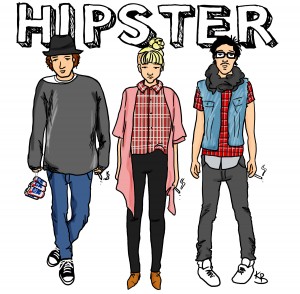MONTREAL (CUP) – What do you think of when you hear the word “hipster”? For hipster haters, it’s an arrogant trend follower, who loves sarcasm and drinking Pabst Blue Ribbon while wearing black, thick-rimmed glasses with no lenses. It’s clear to see that “hipster” has become an overused word that has lost its significance and impact due to mainstream popularity.

Zeynep Arsel, who jokingly calls herself a “hipsterologist,” is an assistant professor in Concordia’s marketing department. Her doctoral dissertation looked at “the intersection of indie culture and mass mediated hipster narrative and the consumption patterns that emerge as a result of this co-optation.”
Arsel explains how marketers began pegging people with the term “hipster.” “We’re talking about ’90s. This was where indie music was very exotic and interesting and nothing like anything out there. Marketers were trying to understand, and I was looking at, the media discourse about indie music,” she says.
Journalists and marketers gradually began to label and categorize people in the indie culture as hipsters, according to Arsel.
“I don’t know what the challenge was with [labelling] indie, but it was sort of a production system rather than a lifestyle,” she says. “Using hipster helped them understand what indie was about.”
Arsel explains that marketers “cool-hunt” for subcultures and new styles in areas where the culture is merely emerging. They “find stylistic cues, fashion, and make them mainstream,” she says.
This happened with hipsters, who were originally discovered in the New York City borough of Brooklyn, and Williamsburg, one of its neighbourhoods. These individuals, who were 18 to 35, were edgy and had interesting taste in music and fashion.
Hipsters aim to stand out in a crowd, yet they all look the same. The hipster style is a mix of all other countercultures and actually shows little originality: oversized glasses of the ’80s, unflattering sweaters from dad’s closet, and beards from the Paleolithic period.
Stereotypically, hipsters are young people who believe in forward thinking, helping the environment, and think of themselves highly. Hipsters live and dress like aspiring artists, but spend copious amounts of money on the latest Apple technologies.
It’s easy to list the stereotypes, but there’s more to the hipster label than what mocking photoblog Look at That Fucking Hipster tells you. Despite popular belief, hipsters aren’t just attention seekers.
“I have a lot of disagreement with people who talk about hipsters, and say, ‘Hipsters are trend-seeking people.’ In most cases, hipsters actually really like the music they listen to and like to dress a certain way,” says Arsel.
She also sees people stereotype others as hipsters when they only borrow from the counterculture.
“In every group, there are always the people who are hardcore, and people who paraphrase and emulate. There are always people who are the tail end of the moment,” says Arsel.
Because the hipster style of frumpy sweaters and skinny jeans can be bought at Urban Outfitters and American Apparel, it has become conventional.
“It’s a way people go back in time and remember the ‘80s and ‘90s, especially people ages 20 to 30,” says Concordia University political science graduate student Juan Diego Santa. “People go back to old fashion to remember everything about the culture, from TV shows, fashion, music. I like the hipster style. It’s original and it reflects people’s appreciation for art.”
Arsel has seen The New York Times use the word “hipster” many times… she’s even seen them apologize for using the word so many times.
“It ceased to be meaningful because anyone can be categorized into the term,” she says. “We talked about it so much that we contaminated it.”
